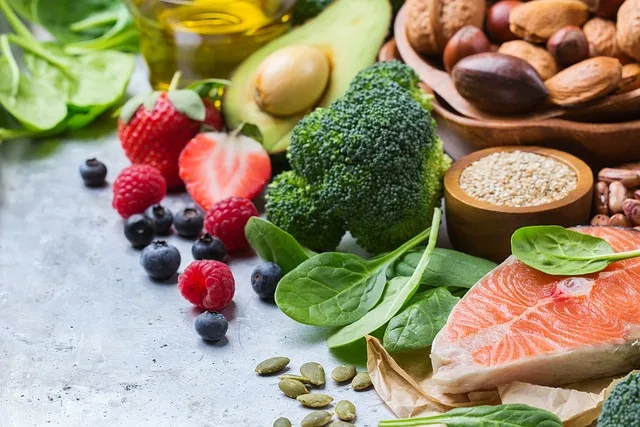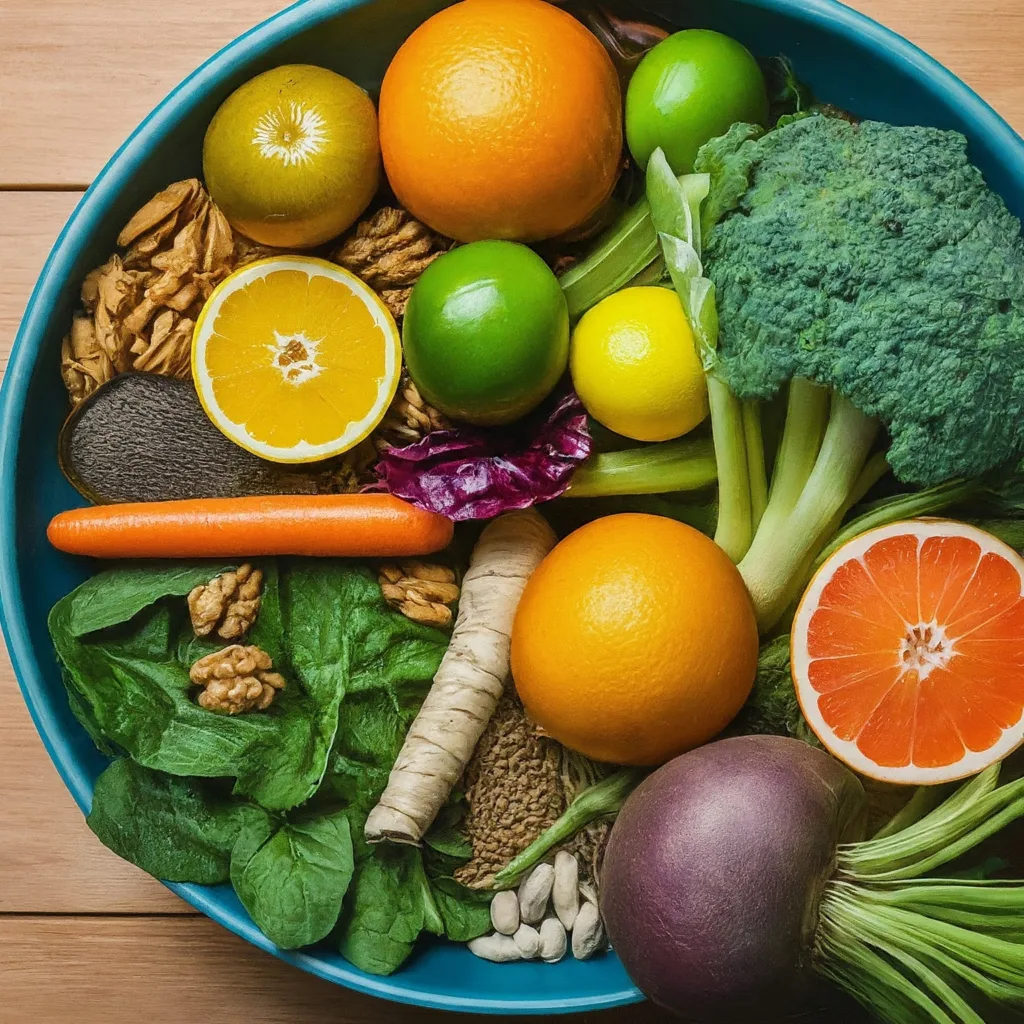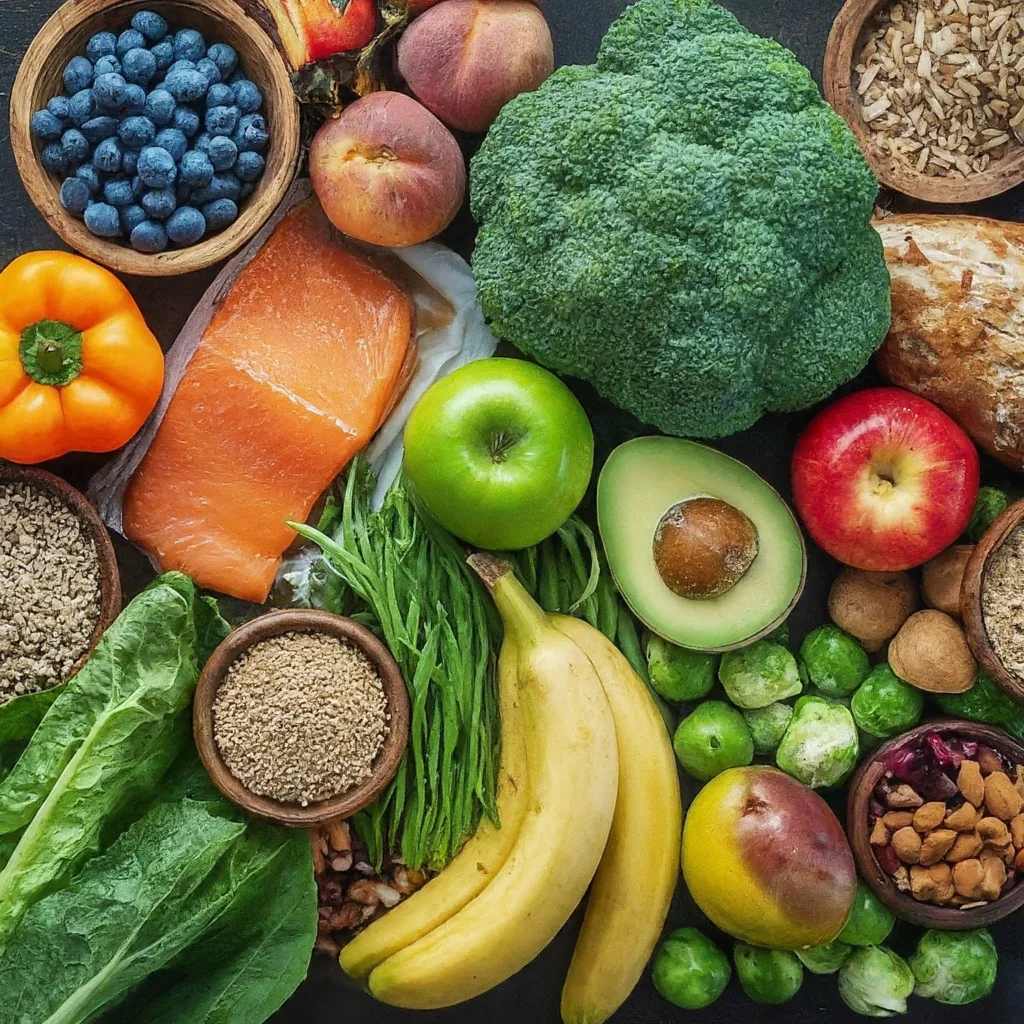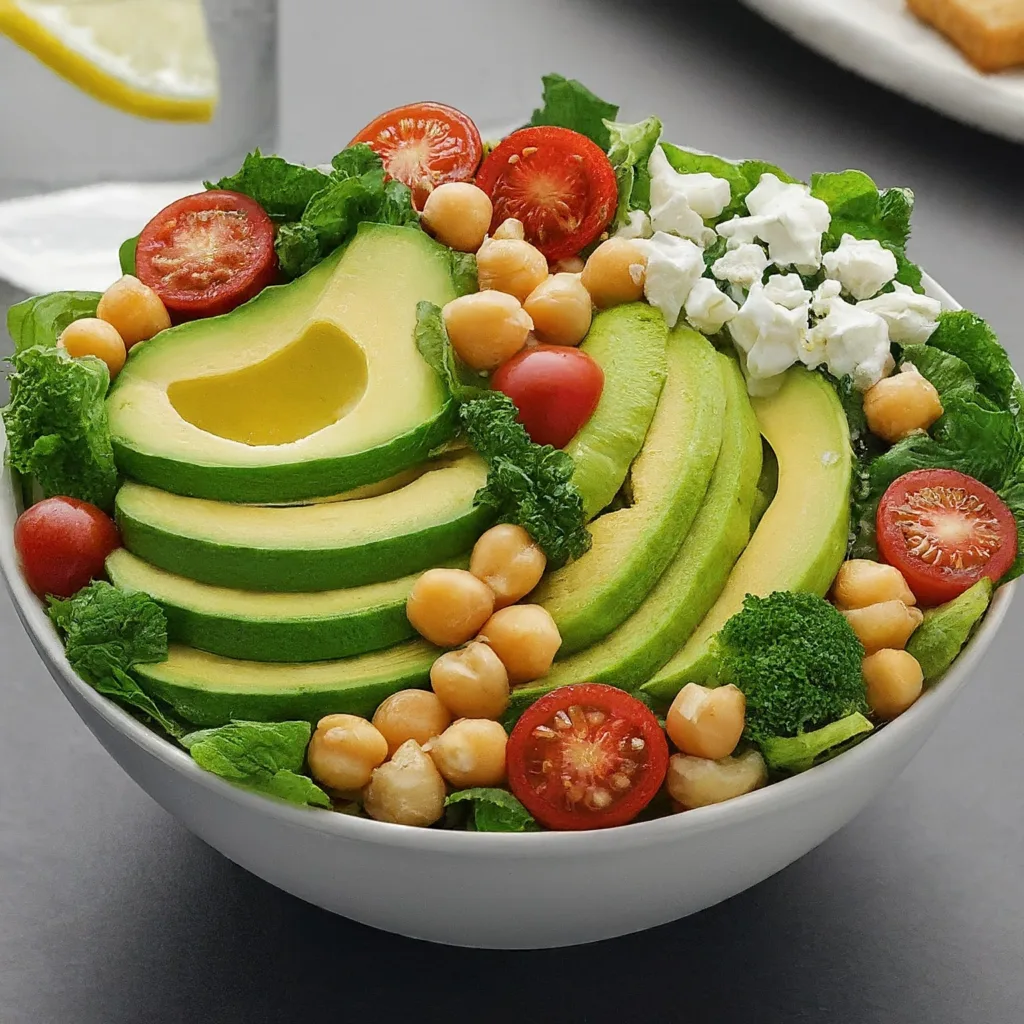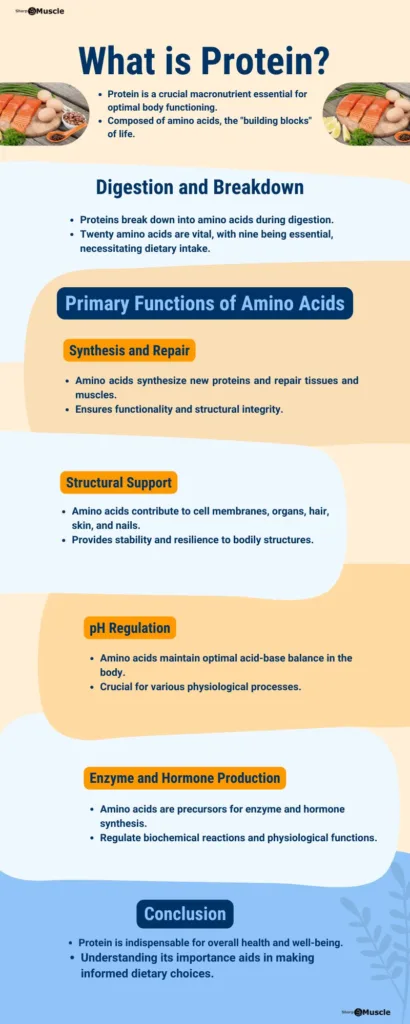Foods rich in nutrients compared to their calorie content are referred to as nutrient-dense foods. This category gives a range of wholesome options, including whole vegetables, fruits, cocoa, seafood, eggs, and liver.
Incorporating these nutrient-dense foods into your diet contributes to its overall healthiness. These superfoods are high in critical vitamins and minerals, and they offer several health advantages. But it’s important to eat a variety of fresh foods because no single food can give you all the nutrients your body needs. In this article, we will talk about the key aspects about foods that have lots of nutrients and how they can help you be healthy.
In This “Nutrient-Dense Foods Guide”
Understanding Nutrient-Dense Foods
Nutrient-dense foods have a high concentration of critical vitamins, minerals, and nutrients that are needed for good health. Most importantly, they are lowering amounts of saturated fat, added sugars, and salt. The concept of food’s nutritional value is based on the ratio of nutrients obtained compared to calories eaten.
Recent research suggests the normal American diet is high in calories but low in essential nutrients. 1
Nutrient-dense Guidelines
Consider the following guidelines that promote a nutrient-dense and heart-healthy nutrients pattern:
Diversify Your Fruit and Vegetable Intake
Eat a variety of fruits and vegetables, such as leafy green vegetables (kale, spinach), citrus, berries, carrots, and red foods – like tomatoes and watermelon, so you can get a wide variety of nutrients. These foods, rich in lycopene, are thought to have an important role in the fight against prostate cancer and heart disease. Consuming fruits and vegetables increases your intake of dietary fiber, which has been linked to a lower risk of cardiovascular disease and obesity. 2
Furthermore, these natural wonders give essential vitamins and minerals while also serving as botanical compounds reservoirs. These substances provide a variety of protective functions, including antioxidants, phytoestrogens, anti-inflammatory agents, and other processes that promote overall wellness and health.
Choose Whole Grains
To enhance your intake of nutrients, include whole grains as an everyday staple of your dietary regimen. Whole grains provide a wide range of health benefits, distinguishing them from refined grains that lose valuable nutrients in the processing stage.
The Whole grains, which are high in fiber, vitamins, and minerals, have a good impact on health by helping to regulate cholesterol, weight, and blood pressure. Their intake is linked to a lower risk of obesity, type 2 diabetes, heart disease, and a variety of other health issues. 3
Prioritize Healthy Protein Sources
Incorporating omega-3 fatty acids into a diet to promote heart health will help to reduce the risk of heart failure, coronary heart disease, cardiac arrest, and the common ischemic stroke. 4 5
Consider plant-based proteins such as legumes and beans including pinto, kidney, garbanzo, and soybeans, seafood such as shellfish and fish, fat-free or low-fat dairy, and lean cuts of unprocessed meat and skinless chicken. Plant-based protein sources, such as beans, are low in saturated fats and high in dietary fiber along with other essential nutrients. Additionally, nuts, peanuts, and soybeans are rich in healthy unsaturated fats.
Include Nuts and Beans
Incorporate nuts and beans into your diet for increased nutritious benefits.
A diet rich in fruits, vegetables, whole grains, legumes (beans), nuts, and seeds has been linked to significantly lower the risk of heart disease, high blood pressure, stroke, and type 2 diabetes. 6
Restrict red and processed meats, sodium, added sugars, and alcohol
Limit your intake of red and processed meats, as well as salt, added sweets, and alcohol, for better heart health.
Smoking, curing, salting, fermentation, and the addition of preservatives are all processes used to process meat. Fresh roasted fowl, nut butters, hummus, and bean spreads are healthier sandwich and lunch options than processed foods like hot dogs, bacon, sausage, and deli meats.
According to the latest research, consuming red and processed meat increases the risk of heart disease, stroke, diabetes, bowel and stomach cancer, and it may also contribute to pancreatic cancer and death. 7 8
Processed meat, like smoking and alcohol, is classified as a Group 1 carcinogen, which means it is a ‘definite’ cause of cancer. Particularly, it has a greater association with colon cancer than red meat. Making mindful meat consumption decisions can play a significant role in improving overall health and lowering cancer risks.
Take into consideration the Nutrition Facts labels
When reviewing Nutrition Facts labels, compare products to find the most healthy alternative. For example, when comparing two bread packages, white bread may have about 80 calories per slice but lacks critical vitamins and minerals. The whole-grain variant, with a similar calorie count, has more protein, double the magnesium, and more than double the fiber, potassium, vitamin B6, and zinc. This nutritional examine highlights whole grains as the most nutrient-dense and healthier option.
The Most Nutrient-Dense Foods List
This table showcases a variety of nutrient-dense foods, each offering a unique combination of essential vitamins, minerals, and other beneficial compounds.
| Nutrient-Dense Foods | Nutrient Content |
|---|---|
| Spinach | Rich in iron, vitamins A and K, and antioxidants. |
| Kale | High in vitamins C and K, and a good source of fiber. |
| Broccoli | Packed with vitamins C and K, fiber, and antioxidants. |
| Blueberries | Loaded with antioxidants, vitamin C, and fiber. |
| Salmon | High in omega-3 fatty acids, protein, and vitamin D. |
| Sweet Potatoes | A great source of beta-carotene, vitamins, and fiber. |
| Quinoa | Contains protein, fiber, and various vitamins and minerals. |
| Almonds | Rich in healthy fats, protein, vitamin E, and magnesium. |
| Chia Seeds | High in omega-3 fatty acids, fiber, and protein. |
| Greek Yogurt | A good source of protein, probiotics, and calcium. |
| Eggs | Packed with protein, vitamins B12, D, and selenium. |
| Avocado | Rich in healthy fats, potassium, and vitamins C, E, K, B6. |
| Black Beans | High in fiber, protein, and various vitamins and minerals. |
| Oats | Provide fiber, protein, and numerous vitamins and minerals. |
| Lentils | A good source of protein, fiber, and various nutrients. |
| Brussels Sprouts | Rich in vitamins C and K, fiber, and antioxidants. |
| Oranges | High in vitamin C, fiber, and various antioxidants. |
| Bell Peppers | Packed with vitamin C, A, and antioxidants. |
| Sunflower Seeds | A good source of healthy fats, protein, and vitamin E. |
| Fatty Fish (Mackerel) | High in omega-3 fatty acids, protein, and vitamin D. |
| Beets | Rich in folate, manganese, and antioxidants. |
| Carrots | Loaded with beta-carotene, fiber, and vitamins. |
| Cauliflower | High in fiber, vitamins C and K, and antioxidants. |
| Pumpkin Seeds | A good source of magnesium, zinc, and healthy fats. |
| Strawberries | Rich in vitamin C, manganese, and antioxidants. |
| Swiss Chard | High in vitamins A, C, and K, and minerals like magnesium. |
| Turkey Breast | A lean source of protein, B vitamins, and zinc. |
| Tomatoes | Packed with vitamin C, potassium, and antioxidants. |
| Asparagus | High in vitamins A, C, and K, and a good source of fiber. |
| Walnuts | Rich in omega-3 fatty acids, antioxidants, and protein. |
| Brussels Sprouts | A nutrient-dense vegetable with vitamins and fiber. |
Benefits of Prioritizing Nutrient-Dense Foods Choice
1. Enhanced Nutrient Absorption
By prioritizing nutrient-dense foods, you enhance your body’s capacity to absorb and make use of essential nutrients. These foods typically have a higher bioavailability of vitamins and minerals, resulting in an overall improvement in nutrient absorption and utilization.
However, choosing nutrient-dense foods can enhance nutrient absorption in several ways:
- Bioavailability of Nutrients: Nutrient-dense foods often present nutrients in forms that the body can readily absorb. For instance, iron from plant-based sources (non-heme iron) may have lower absorption compared to the iron found in meat (heme iron). Including a diverse range of nutrient-dense foods ensures a broad spectrum of bioavailable nutrients.
- Synergistic Nutrient Interactions: Some nutrients collaborate synergistically, enhancing each other’s absorption and utilization. For example, vitamin C boosts the absorption of non-heme iron from plant sources. Consuming nutrient-dense foods with complementary nutrients optimizes the simultaneous absorption of multiple nutrients.
- Fiber Content: Nutrient-dense foods like fruits, vegetables, and whole grains are often rich in dietary fiber. This fiber positively influences nutrient absorption by fostering a healthy gut environment. Additionally, it aids in regulating blood sugar levels and promoting the growth of beneficial gut bacteria.
- Phytochemicals and Antioxidants: Particularly abundant in fruits and vegetables, nutrient-dense foods boast high levels of phytochemicals and antioxidants. These compounds provide protective effects, supporting overall health and potentially enhancing the absorption of specific nutrients.
- Healthy Fats: Certain vitamins, such as A, D, E, and K, are fat-soluble and absorb better in the presence of dietary fats. Nutrient-dense choices containing healthy fats, like avocados, nuts, and olive oil, contribute to the absorption of fat-soluble vitamins.
- Digestive Enzymes: Some nutrient-dense foods, including raw fruits and vegetables, contain enzymes that aid in the digestion and absorption of nutrients. These enzymes support the body’s natural digestive processes, facilitating optimal nutrient uptake.
- Balanced Diet: Maintaining a well-balanced diet with a variety of nutrient-dense foods ensures that the body receives a comprehensive combination of vitamins, minerals, and essential nutrients. This balance is pivotal for overall health and plays a significant role in enhancing nutrient absorption.
2. Sustainable Energy Levels
Choosing nutrient-dense foods offers many benefits to sustaining energy levels. Take into consideration the following ways in which prioritizing nutrient-rich choices promotes sustained energy levels:
- Steady Blood Sugar Levels: Nutrient-dense foods, including whole grains, fruits, vegetables, and lean proteins, often boast high levels of complex carbohydrates. These carbohydrates release glucose into the bloodstream gradually, ensuring a stable and sustained source of energy. This helps prevent abrupt spikes and crashes in blood sugar levels, averting fluctuations in energy levels.
- Sustained Release of Energy: Nutrient-dense options feature a blend of macronutrients (carbohydrates, proteins, and fats) that undergo varying rates of breakdown and absorption. This results in a more prolonged release of energy throughout the day, sidestepping the rapid energy surges and subsequent crashes associated with processed and sugary foods.
- Mitigation of Nutrient Deficiencies: Nutrient-dense foods supply a diverse range of vitamins and minerals crucial for energy metabolism. Deficiencies in essential nutrients like iron, B-vitamins, and magnesium can induce fatigue and diminish energy levels. Prioritizing nutrient-dense choices ensures a sufficient supply of these vital nutrients.
- Improved Digestive Health: A diet abundant in fiber, prevalent in fruits, vegetables, whole grains, and legumes, fosters digestive health. An efficient digestive system enhances nutrient absorption, promoting overall well-being and sustained energy levels.
- Balanced Macronutrient Intake: Nutrient-dense selections contribute to a harmonized intake of macronutrients. Proteins, fats, and carbohydrates all play pivotal roles in energy production and bodily function maintenance. A balanced intake guarantees the availability of essential building blocks for sustained energy.
- Reduced Inflammation: Certain nutrient-dense foods, particularly those abundant in antioxidants and anti-inflammatory compounds (such as fruits, vegetables, and omega-3 fatty acids), may assist in diminishing inflammation in the body. Chronic inflammation can contribute to feelings of fatigue and low energy levels.
- Hydration Support: Numerous nutrient-dense foods, such as fruits and vegetables, boast high water content, contributing to hydration. Adequate hydration is indispensable for overall energy and metabolic function.
3. Support for Weight Management
Prioritizing nutrient-dense food options can help with weight management in a many ways, here are key advantages:
- Satiety and Reduced Caloric Intake: Loaded with nutrients foods, which are high in fiber, protein, and healthy fats, promote fullness and satisfaction. This efficiently reduces total caloric intake by preventing overeating and limiting the consumption of empty-calorie foods.
- Nutrient Satisfaction: A nutrient-dense diet ensures that your body gets the vitamins and minerals it needs to function properly. This reduces appetites for harmful alternatives used to meet nutritional requirements.
- Stable Blood Sugar Levels: Nutrient-dense choices, particularly those high in fiber and complex carbohydrates, assist in regulating blood sugar levels. This preventive measure curtails energy crashes and subsequent cravings for sugary or high-calorie snacks.
- Metabolism Support: Several nutrients, including vitamins and minerals, play essential functions in the processes of metabolism. Adequate nutrition supports the efficient operation of your metabolism, which is a key factor in healthy weight management.
- Muscle Maintenance and Development: Protein, found in a variety of nutrient-dense foods, is essential for maintenance and and building muscle. Maintaining lean muscle mass is essential for a metabolism that is functioning properly, which may contribute to weight loss by increasing resting calorie burn.
- Improved Digestive Health: Many nutrient-dense foods, especially fruits, vegetables, and whole grains, boast high fiber content. Fiber promotes digestive health, sustains a balanced gut microbiome, and fosters a feeling of fullness—all aiding in weight management.
- Reduced Risk of Nutrient Deficiencies: Giving preference to nutrient-dense options helps as a safeguard step against nutritional deficits, hence protecting the entire body. This proactive strategy reduces the chance of overeating while the body works to satisfy its nutritional needs.
Bottom line
Prioritizing nutrient-dense foods is crucial for optimal health, sustained energy, and effective weight management.
The table features 30 nutrient-packed foods, rich in essential vitamins, minerals, and antioxidants. These foods offer benefits such as satiety, stable blood sugar, metabolic support, and muscle maintenance.
Living a healthy lifestyle that includes lots of nutrients helps you eat a balanced diet, reduces the chance of not getting enough nutrients, and makes you feel better overall. Make informed choices to unlock the full potential of a vibrant and thriving life.
FAQs – Frequently Asked Questions
- Institute of Medicine (US) Committee on Examination of Front-of-Package Nutrition Rating Systems and Symbols; Wartella EA, Lichtenstein AH, Boon CS, editors. Front-of-Package Nutrition Rating Systems and Symbols: Phase I Report. Washington (DC): National Academies Press (US); 2010. “4, Overview of Health and Diet in America.” Available from: https://www.ncbi.nlm.nih.gov/books/NBK209844/.[↩]
- Slavin JL, Lloyd B. “Health benefits of fruits and vegetables.” Adv Nutr. 2012 Jul 1;3(4):506-16. doi: 10.3945/an.112.002154. PMID: 22797986; PMCID: PMC3649719.[↩]
- P NPV, Joye IJ. “Dietary Fibre from Whole Grains and Their Benefits on Metabolic Health.” Nutrients. 2020 Oct 5;12(10):3045. doi: 10.3390/nu12103045. PMID: 33027944; PMCID: PMC7599874.[↩]
- Richter CK, Skulas-Ray AC, Champagne CM, Kris-Etherton PM. “Plant protein and animal proteins: do they differentially affect cardiovascular disease risk?” Adv Nutr. 2015 Nov 13;6(6):712-28. doi: 10.3945/an.115.009654. PMID: 26567196; PMCID: PMC4642426.[↩]
- Kar S, Webel R. “Fish oil supplementation & coronary artery disease: does it help?” Mo Med. 2012 Mar-Apr;109(2):142-5. PMID: 22675796; PMCID: PMC6181727.[↩]
- Polak R, Phillips EM, Campbell A. “Legumes: Health Benefits and Culinary Approaches to Increase Intake.” Clin Diabetes. 2015 Oct;33(4):198-205. doi: 10.2337/diaclin.33.4.198. PMID: 26487796; PMCID: PMC4608274.[↩]
- Micha R, Wallace SK, Mozaffarian D. “Red and processed meat consumption and risk of incident coronary heart disease, stroke, and diabetes mellitus: a systematic review and meta-analysis.” Circulation. 2010 Jun 1;121(21):2271-83. doi: 10.1161/CIRCULATIONAHA.109.924977. Epub 2010 May 17. PMID: 20479151; PMCID: PMC2885952.[↩]
- IARC Working Group on the Evaluation of Carcinogenic Risks to Humans. Red Meat and Processed Meat. Lyon (FR): International Agency for Research on Cancer; 2018. (IARC Monographs on the Evaluation of Carcinogenic Risks to Humans, No. 114.) “2. CANCER IN HUMANS.” Available from: https://www.ncbi.nlm.nih.gov/books/NBK507972/.[↩]


